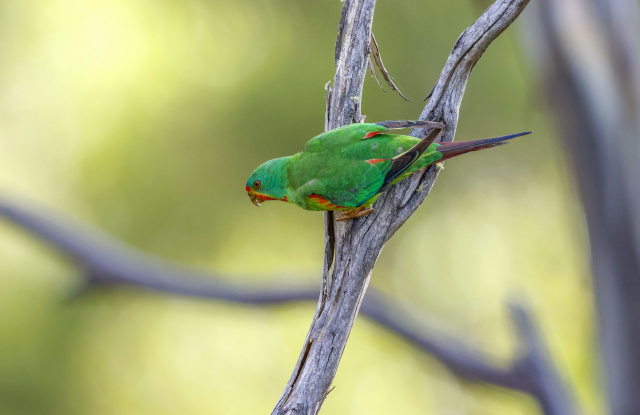Bruny Island: Critical habitat site for birds
In my role in BirdLife Australia, we have a woodland bird conservation action plan. It identifies 51 in decline species across woodlands from Tasmania, all the way up to Queensland. And those species are in rapid decline. There are a number of those birds that are listed Federally as Threatened, and that includes the 40-Spotted Pardalote, and the Swift Parrot.
Cover Image: Forty-Spotted Pardalote, Kim Murray

It has nest hollows and suitable forage and flowering trees within their foraging range, needed for them to maintain their population, that is ever declining. This is the habitat that the Swift Parrots require each year to produce their two or three young in a nest in their hollows. But it is also an island that is free of the Sugar Glider – a key introduced predator for the bird.
The available habitat, and that expansive habitat, that expansive forest remnant habitat, is really important for those Swift Parrots. They breed in the hollows, and then they move about, in a 9 - 10 kilometre range, in search for blossom, because they also are feeding while they're raising their chicks.
They need that expansive habitat.

In my role in BirdLife Australia, we have a woodland bird conservation action plan. It identifies 51 in decline species across woodlands from Tasmania, all the way up to Queensland. And those species are in rapid decline. There are a number of those birds that are listed Federally as Threatened, and that includes the 40-Spotted Pardalote, and the Swift Parrot.
Cover Image: Forty-Spotted Pardalote, Kim Murray

It has nest hollows and suitable forage and flowering trees within their foraging range, needed for them to maintain their population, that is ever declining. This is the habitat that the Swift Parrots require each year to produce their two or three young in a nest in their hollows. But it is also an island that is free of the Sugar Glider – a key introduced predator for the bird.
The available habitat, and that expansive habitat, that expansive forest remnant habitat, is really important for those Swift Parrots. They breed in the hollows, and then they move about, in a 9 - 10 kilometre range, in search for blossom, because they also are feeding while they're raising their chicks.
They need that expansive habitat.

You might like...

Bruny Island launch: Bob Graham on the hidden world behind the photos
In this series we'll introduce you to some key people involved in building the Bruny Island field guide. Here, geologist and convenor of the Bruny Island Environment Network Bob Graham talks about the hidden world you don't see through the tourist photos.

Watch: behind the scenes at the Bruny Island Bird Festival
The Bruny Island Bird Festival celebrated its 7th festival in March this year. Held every two years, the biennial event is becoming ever-more popular, thanks to a dedicated and passionate cohort of bird ecologists, ornithologists, Nature lovers and the Bruny Island community. Join film-maker Marcio Conrado as he goes behind the scenes to capture the wonder.

Maasai Mara
Maasai Mara is the northern reaches of the Mara-Serengeti ecosystem, one of the most important wildlife areas and wild landscapes in Africa

Freestyle Polo
Shandur (3,700 m) is where the three mountain ranges - Hindukush, Himalaya, and Karakoram - meet. Here can be found the highest polo ground on earth
Newsletter
Sign up to keep in touch with articles, updates, events or news from Kuno, your platform for nature
